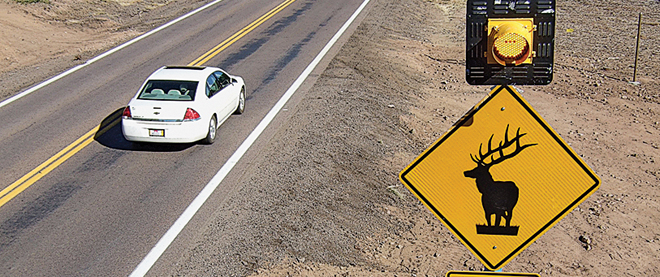What’s being done to keep cars from crashing into moose
Infrared beams, military tracking software—how we’re waking up the lumbering giants
Robert C. Nunnington/Getty Images
Share

 Moose aren’t native to Newfoundland, but the province has proven a paradise for the spindly-legged interlopers. All the island’s estimated 120,000 moose—some say there could even be as many as 200,000 munching through the landscape—descend from six moose brought there as hunting fodder over a century ago (two in 1878, from Nova Scotia, four more in 1904, from New Brunswick), an arrival coinciding, happily for the moose, with the decline of the predacious Newfoundland wolf, now extinct.
Moose aren’t native to Newfoundland, but the province has proven a paradise for the spindly-legged interlopers. All the island’s estimated 120,000 moose—some say there could even be as many as 200,000 munching through the landscape—descend from six moose brought there as hunting fodder over a century ago (two in 1878, from Nova Scotia, four more in 1904, from New Brunswick), an arrival coinciding, happily for the moose, with the decline of the predacious Newfoundland wolf, now extinct.
Today, Newfoundland boasts what’s understood to be the world’s highest-density moose population, a scourge to motorists. With as many as 800 collisions a year, everyone has a story about hitting one, vehicular encounters that can be fatal for drivers as well as for moose. “They’re basically a one-tonne animal on these long legs,” says wildlife scientist Tony Clevenger, who recently wrote a report on the trouble. “The whole body comes right through the windshield.” These accidents each year result in deaths—one so far in 2011, “but last year we had two, the year before that four,” says Eugene Nippard, a leader of the Save Our People Action Committee, which lobbies the province for anti-moose measures. (Nippard speaks longingly of the days when authorities still allowed charities to raffle off roadkill meat.)
All this makes moose an emotional, and frequently political, issue in Newfoundland. A class-action suit, stickhandled by accident and injury lawyer Ches Crosbie, the son of Newfoundland politician John Crosbie, has been filed against the province. Some propose a major cull of 50,000—an unpopular option for outfitters, who make a tidy living guiding U.S. hunters (“because the success rate for hunting moose in Newfoundland is—you know—better than anywhere in the world,” says Clevenger). Moose were even an issue during the recent provincial election: the Grits pledged to erect fencing and negotiate a settlement with class actioners. The Tories (who won) announced pilot projects that will see $5 million spent on 15 km of fencing and two wildlife detection systems.
That latter move puts the province on the cutting edge of efforts to tamp down on wildlife collisions, a North American trend that happens to have a very Canadian entrepreneurial streak to it. While many regions with wildlife troubles on their roads (west Alberta, say) have responded with over- and underpasses that let animals across thoroughfares to access new habitats, these are costly and take time to build. The technology now used in Newfoundland, installed by a Mississaugabased company, is cheaper and quicker—the first of the two systems, on a 1.5-km stretch of the Trans Canada west of St. John’s, whirred into action in mid-October, mere weeks after the province announced it. The device uses infrared beams mounted in pairs at varying heights; when an animal breaks both beams at once—an indication it’s something of size rather than, say, a rabbit—signs placed at either end of the 1.5-km section begin blinking. “Moose on Highway When Lights Are Flashing,” the signs read. The province selected the section based on the high number of collisions there, though it’s not clear why fencing, which is cheaper, wasn’t erected instead (government officials were skittish about discussing the measures).
To see a truly state-of-the-art system, Newfoundland could have gone to nearby Yarmouth, N.S., where ElectroBraid Fence makes a system that combines fencing, infrared cameras and high-grade military tracking software to create what are, in effect, moose “crosswalks” at wildlife hot spots along the highway. Once an animal enters an unfenced crossing corridor, a sign flashes to alert motorists—“ just like a crosswalk in the city, except wider and deeper,” says Richard Lampman, the system’s London, Ont.-based co-inventor. Working out of his garage, Lampman also developed what he calls “electro-mats,” which run along the asphalt over the length of the crossing and deliver mild electric shocks to animals who stray up or down the road, keeping them from getting trapped on the fenced highway and panicking—“the worst scenario you’d want,” he says.
ElectroBraid pioneered the system in 2007, in central Arizona, where elk posed the problem; it reduced the dozen-or-so collisions a year on the route to nearly nil. The company has gone on to install the systems in several U.S. states, in Quebec and New Brunswick, and at the Wasilla municipal airport—Sarah Palin’s stomping ground in Alaska—where moose are now more worried about helicopters.
*****
MAKE THIS STORY COME ALIVE WITH AUGMENTED REALITY

